
A hamadryad is a Greek mythological being that lives in trees. It is a particular type of dryad - which, in turn, is a particular type of nymph. Hamadryads are born bonded to a certain tree. Some maintain that a hamadryad is the tree itself, with a normal dryad being simply the indwelling entity, or spirit, of the tree. If the tree should die, the hamadryad associated with it would die as well. For this reason, both dryads and gods would punish mortals who harmed trees.

Colophospermum mopane, commonly called mopane, mopani, balsam tree, butterfly tree, or turpentine tree, is a tree in the legume family (Fabaceae), that grows in hot, dry, low-lying areas, 200 to 1,150 metres in elevation, in the far northern parts of southern Africa. The tree only occurs in Africa and is the only species in genus Colophospermum. Its distinctive butterfly-shaped (bifoliate) leaf and thin seed pod make it easy to identify. In terms of human use it is, together with camel thorn and leadwood, one of the three regionally important firewood trees.

Idea malabarica, the Malabar tree nymph, is a large butterfly found in peninsular India. that belongs to the danaid group of the family Nymphalidae. It is found in forest clearings and above the forest canopy.
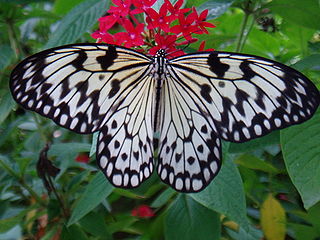
Idea is a genus of butterflies known as tree nymphs or paper butterflies. The member species are concentrated around South-East Asia. See Sevenia for the genus of African tree nymphs.

Ideopsis is a genus of nymphalid butterflies in the subfamily Danainae found in South-east Asia.

The Ceylon tree nymph is a species of nymphalid butterfly in the subfamily Danainae. It is endemic to Sri Lanka. First described by John Westwood in 1848, the Ceylon tree nymph can be found in both wet and dry zones of Sri Lanka. It is the largest member of the family Danaidae in that country. It is listed as a near threatened species in the IUCN Red List.
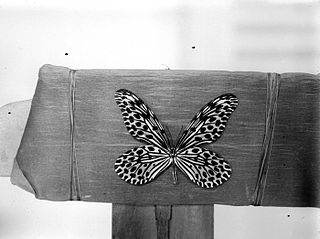
Idea stolli, the common tree nymph, is a species of nymphalid butterfly in the Danainae subfamily. It is found in South East Asia. There are twelve Idea species, of which five occur in West Malaysia.
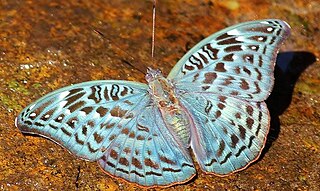
Euryphura achlys, the forest green butterfly or mottled-green nymph, is a butterfly of the family Nymphalidae. The southernmost limit is Ongoye Forest, South Africa. It is also found in the forests of eastern Zimbabwe, around Mulanje Massif in south eastern Malawi, Mozambique and Kenya.

Deinbollia oblongifolia is a shrub or small tree in the family Sapindaceae. It is commonly known as the dune soap-berry and is found in coastal vegetation from the Eastern Cape of South Africa, through KwaZulu-Natal to southern Mozambique and Swaziland. It is named after Peter Vogelius Deinboll (1783-1876), a Danish botanist and plant collector.

Zophopetes dysmephila, the palm-tree nightfighter, is a butterfly of the family Hesperiidae. It is found in Mozambique, in South Africa from Port Elizabeth in the Eastern Cape to KwaZulu-Natal and Mpumalanga, and in Kenya. The habitat consists of moist savanna and forests.

Sevenia, commonly called tree nymphs, is a genus of forest butterflies in the family Nymphalidae that, as larvae, feed on plants of the family Euphorbiaceae. There are fourteen species from continental Africa and two species from Madagascar. See Idea for the genus of Southeast Asian tree nymphs.

Sevenia boisduvali, the Boisduval's tree nymph, is a butterfly in the family Nymphalidae. There are four subspecies; all native to Africa.
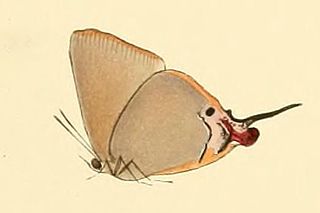
Myrina dermaptera, the lesser fig-tree blue or scarce fig-tree blue, is a butterfly of the family Lycaenidae. It is found in Sub-Saharan Africa, southern Arabia and northern Oman.

Sevenia rosa, or Rosa's tree nymph, is a butterfly in the family Nymphalidae found in South Africa.

Sevenia natalensis, the Natal tree nymph, is a butterfly in the family Nymphalidae found in southeastern Africa.

Azanus moriqua, the black-bordered babul blue or thorn-tree blue, is a butterfly of the family Lycaenidae. It is found in the Afrotropical realm.
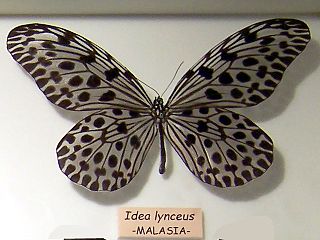
Idea lynceus, the tree-nymph, is a species of nymphalid butterfly in the Danainae subfamily. It is found in South East Asia.
Tree nymph is another term for a Dryad in Ancient Greek mythology.

Sevenia pechueli, the spotted lilac tree nymph, is a butterfly in the family Nymphalidae. It is found in Nigeria, Cameroon, the Republic of the Congo, Angola, the Democratic Republic of the Congo, the Central African Republic, Tanzania, Malawi, Zambia and Namibia. The habitat consists of woodland, especially in marshy areas.
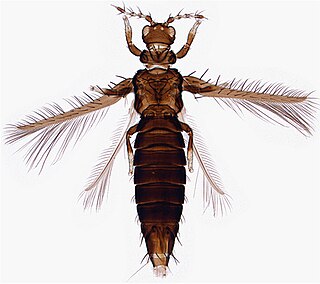
Selenothrips rubrocinctus, commonly known as the redbanded thrips, is a species of thrips in the family Thripidae. It was first described from the West Indies but may have originated in northern South America. It has spread to other parts of the world and now has a near pan-tropical distribution, occurring in North, Central, and South America, Africa, southern Asia, and Australasia.


















